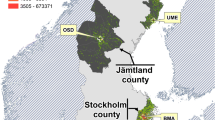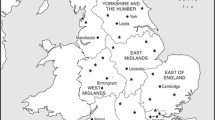Abstract
Previous research using varying methods has shown that the day-to-day variability in cardiovascular (CV)-related mortality is correlated with a number of different meteorological variables, though these relationships can vary geographically. This research systematically examines the relationship between anomalous winter CV-related mortality and geographically and seasonally relative multivariate surface weather types derived from a recently developed gridded weather typing classification (GWTC) for cities in varying climate regions of the United States of America (USA). Results indicate that for all locations examined, during winter, a dry and cool (DC) weather type is significantly related to increased CV-related mortality, especially in the 2 weeks immediately after it occurs, with no apparent mortality displacement. Across the USA as a whole, the peak of this relationship is a 4.1% increase in CV-related mortality at a lag of 3 days. Spike days in CV-related mortality show similar trends, being over 50% more likely 2 to 4 days after the DC type occurs. A humid and warm (HW) weather type exhibited a significant and opposite relationship to that of DC. While these results for DC and HW were statistically significant at every location examined, the magnitudes were larger in the warmer locations. Among other weather types, Warm Front Passages (WFP) were also related to significant increases in CV-related mortality, especially 1 day after they occurred. Though this link was much more varied geographically than results found with DC or HW, it suggests that sequences of multiple DC days followed by WFP may result in increased CV-related mortality.




Similar content being viewed by others
Abbreviations
- ATL:
-
Atlanta, Georgia
- BOS:
-
Boston, Massachusetts
- BWI:
-
Baltimore, Maryland
- CLE:
-
Cleveland, Ohio
- DCA:
-
Washington, D. C.
- DFW:
-
Dallas/Fort Worth, Texas
- DTW:
-
Detroit, Michigan
- IAH:
-
Houston, Texas
- LAX:
-
Los Angeles, California
- LGA:
-
New York City, New York
- MIA:
-
Miami, Florida
- ORD:
-
Chicago, Illinois
- PHL:
-
Philadelphia, Pennsylvania
- PIT:
-
Pittsburgh, Pennsylvania
- SAN:
-
San Diego, California
- SEA:
-
Seattle, Washington
- SFO:
-
San Francisco, California
- STL:
-
St. Louis, Missouri
- TPA:
-
Tampa, Florida
- C:
-
Cool
- CFP:
-
Cold Front Passage
- D:
-
Dry
- DC:
-
Dry Cool
- DW:
-
Dry Warm
- H:
-
Humid
- HC:
-
Humid Cool
- HW:
-
Humid Warm
- S:
-
Seasonal
- W:
-
Warm
- WFP:
-
Warm Front Passage
- ADCVM:
-
Anomalous daily cardiovascular mortality (%)
- CV:
-
Cardiovascular
- GWTC:
-
Gridded weather typing classification
- SDR:
-
Spike day ratio
- WT:
-
Weather type
References
Allen MJ, Lee CC. 2014. Investigating high mortality during the cold season: mapping mean weather patterns of temperature and pressure. Theor Appl Climatol In Press
Allen MJ, Sheridan SC (2013) High-mortality days during the winter season: comparing meteorological conditions across 5 US cities. Int J Biometeorol 58(2):217–225
Analitis A, Katsouyanni K, Biggeri A, Baccini M, Forsberg B, Bisanti L, Kirchmayer U, Ballester F, Cadum E, Goodman PG, Hojs A, Sunyer J, Tiittanen P, Michelozzi P (2008) Effects of cold weather on mortality: results from 15 European cities within the PHEWE project. Am J Epidemiol 168:1397–1408
Anderson BG, Bell ML (2009) Weather-related mortality how heat, cold, and heat waves affect mortality in the United States. Epidemiology 20:205–213
Atsumi A, Ueda K, Irie F, Sairenchi T, Iimura K, Watanabe H, Iso H, Ota H, Aonuma K (2013) Relationship between cold temperature and cardiovascular mortality, with assessment of effect modification by individual characterisitcs—Ibaraki Prefectual Health Study. Circ J 77:1854–1861. doi:10.1253/circj.CJ-12-091
Barnett AG (2007) Temperature and cardiovascular deaths in the US elderly, changes over time. Epidemiology 18(3):369–372
Basu R, Samet JM (2002) Relation between elevated ambient temperature and mortality: a review of the epidemiological evidence. Epidemiological Reviews 24(2):190–202. doi:10.1093/epirev/mxf007
Berko J, Ingram DD, Saha S, Parker JD (2014) Deaths attributed to heat, cold, and other weather events in the United States, 2006–2010. Natl Health Stat Rep 76:1–16
Bhaskaran K, Hajat S, Smeeth L (2011) What is the role of weather in cardiovascular disease? Aging Health 7(1):1–3
Braga ALF, Zanobetti A, Schwartz J (2002) The effect of weather on respiratory and cardiovascular deaths in 12 U.S. cities. Environ Health Perspect 110(9):859–863
Buxton N, Liu C, Dasic D, Moody P, Hope DT (2001) Relationship of aneurysmal subarachnoid hemorrhage to changes in atmospheric pressure: results of a prospective study. J Neurosurg 95(3):391–392
Davis RE, Rossier CE, Enfield KB (2012) The impact of weather on influenza and pneumonia mortality in New York City, 1975–2002: a retrospective study. PLoS One 7(3):e34091. doi:10.1371/journal.pone.0034091
Donaldson GC, Keatinge WR, Näyhä S (2003) Changes in summer temperature and heat-related mortality since 1971 in North Carolina, South Finland, and Southeast England. Environ Res 91:1–7
Grass D, Kane M (2008) The effects of weather on air pollution on cardiovascular and respiratory mortality in Santiago, Chile, during the winters of 1988–1996. Int J Climatol 28:1113–1126. doi:10.1002/joc.1592
Hondula DM, Vanos JK, Gosling SN (2014) The SSC: a decade of climate-health research and future directions. Int J Biometeorol 58(2):109–120
Kalkstein LS, Corrigan PR (1986) A synoptic climatological approach for geographical analysis: assessment of sulfur dioxide concentrations. Ann Assoc Am Geogr 76:381–395
Kysely J, Pokorna L, Kyncl J, Kriz B (2009) Excess cardiovascular mortality associated with cold spells in the Czech Republic. BMC Public Health 9(1):1–11. doi:10.1186/1471-2458-9-19
Lee CC. 2014. The development of a gridded weather typing classification scheme. Int J Climatol In press. DOI: 10.1002/joc.4010.
Lee CC, Sheridan SC, Lin S (2012a) Relating weather types to asthma-related hospital admissions in New York State. Ecohealth 9:427–439. doi:10.1007/s10393-012-0805-5
Lee CC, Ballinger TJ, Domino NA (2012b) Utilizing map pattern classification and surface weather typing to relate climate to the air quality index in Cleveland, Ohio. Atmos Environ 63:50–59
Lin Y-K, Chang C-K, Wang Y-C, Ho T-J (2013) Acute and prolonged adverse effects of temperature on mortality from cardiovascular diseases. PLoS One 8(12):e82678. doi:10.1371/journal.pone.008267
McGregor GR (1999) Winter ischemic heart disease deaths in Birmingham, United Kingdom: a synoptic climatological analysis. Climate Res 13:17–31
McMichael AJ, Wilkinson P, Kovats RS, Pattenden S, Hajat S, Armstrong B, Vajanapoom N, Niciu EM, Mahomed H, Kingkeow C, Kosnik M, O’Neill MS, Romieu I, Ramirez-Aguilar M, Barreto ML, Gouveia N, Nikiforov B (2008) International study of temperature heat and urban mortality: the ‘ISOTHURM’ project. Int J Environ Epidemiol 37:1121–1131
Mesinger F, DiMego G, Kalnay E, Mitchell K, Shafran PC, Ebisuzaki W, Jovic D, Woollen J, Rogers E, Berbery EH, Ek MB, Fan Y, Grumbine R, Higgins W, Li H, Lin Y, Manikin G, Parrish D, Shi W (2006) North American regional reanalysis. Bull Am Meteorol Soc 87:343–360
Morabito M, Crisci A, Grifoni D, Orlandini S, Cecchi L, Bacci L, Modesti PA, Gensini GF, Maracchi G (2006) Winter air-mass-based synoptic climatological approach and hospital admissions for myocardial infarction in Florence, Italy. Environ Res 102:52–60
Morabito M, Crisci A, Orlandini S, Maracchi G, Gensini GF, Modesti PA (2008) A synoptic approach to weather conditions discloses a relationship with ambulatory blood pressure in hypertensives. Am J Hypertens 21(7):748–752
Näyhä S (2002) Cold and the risk of cardiovascular diseases. A review. Int J Circumpolar Health 61(4):373–380
Plavcová E, Kyselý J (2014) Effects of sudden air pressure changes on hospital admissions for cardiovascular diseases in Prague, 1994–2009. Int J Biometeorol 58(6):1327–1337. doi:10.1007/s00484-013-0735-y
Sheridan SC (2002) The redevelopment of a weather-type classification scheme for North America. Int J Climatol 22:51–68
Sheridan SC, Allen MJ, Lee CC, Kalkstein LS (2012a) Future heat vulnerability in California. Part II: projecting future heat related mortality. Clim Change 115(2):291–309
Sheridan SC, Lee CC, Allen MJ, Kalkstein LS (2012b) Future heat vulnerability in California. Part I: projecting future weather types and heat events. Clim Change 115(2):311–326
Urban A, Davidkovova H, Kysely J. 2013. Heat- and cold-stress effects on cardiovascular mortality and morbidity among urban and rural populations in the Czech Republic. Int J Biometeorol In Press. DOI 10.1007/s00484-013-0693-4.
Vanos JK, Hebbern C, Cakmak S (2014) Risk assessment for cardiovascular and respiratory mortality due to air pollution and synoptic meteorology in 10 Canadian cities. Environ Pollut 185:322–332
Wilks DS (2006) Statistical methods in the atmospheric sciences, Second Editionth edn. Academic, Burlington, p 467
Yarnal B (1993) Synoptic climatology in environmental analysis: a primer. Belhaven, Boca Raton
Acknowledgments
The author would like to thank Scott Sheridan in the Department of Geography at Kent State University and Mike Allen in the Department of Political Science and Geography at Old Dominion University for providing the mortality data used in this research. The author would also like to thank the three anonymous reviewers for their helpful comments toward making this a better manuscript. The author declares no conflict of interest for this research.
Author information
Authors and Affiliations
Corresponding author
Electronic supplementary material
Below is the link to the electronic supplementary material.
ESM 1
(PDF 710 kb)
Rights and permissions
About this article
Cite this article
Lee, C.C. A systematic evaluation of the lagged effects of spatiotemporally relative surface weather types on wintertime cardiovascular-related mortality across 19 US cities. Int J Biometeorol 59, 1633–1645 (2015). https://doi.org/10.1007/s00484-015-0970-5
Received:
Revised:
Accepted:
Published:
Issue Date:
DOI: https://doi.org/10.1007/s00484-015-0970-5




